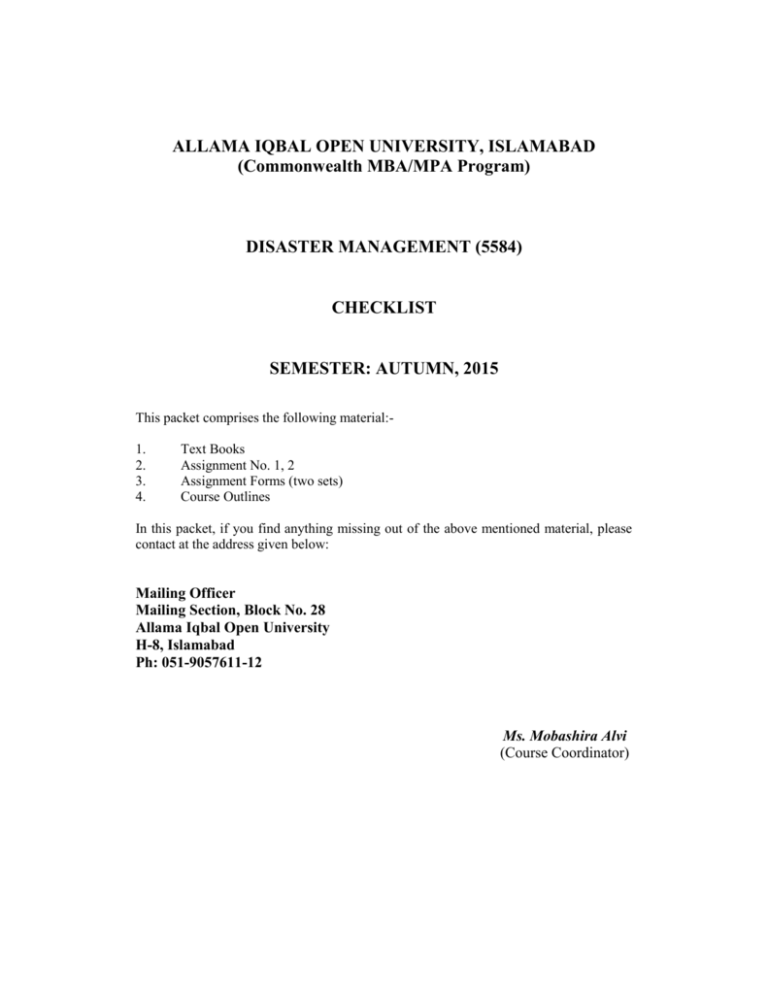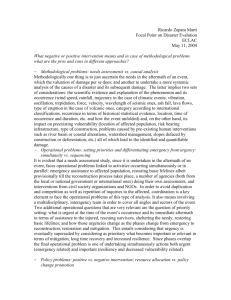Disaster Management (5584) - Allama Iqbal Open University
advertisement

ALLAMA IQBAL OPEN UNIVERSITY, ISLAMABAD (Commonwealth MBA/MPA Program) DISASTER MANAGEMENT (5584) CHECKLIST SEMESTER: AUTUMN, 2015 This packet comprises the following material:1. 2. 3. 4. Text Books Assignment No. 1, 2 Assignment Forms (two sets) Course Outlines In this packet, if you find anything missing out of the above mentioned material, please contact at the address given below: Mailing Officer Mailing Section, Block No. 28 Allama Iqbal Open University H-8, Islamabad Ph: 051-9057611-12 Ms. Mobashira Alvi (Course Coordinator) ALLAMA IQBAL OPEN UNIVERSITY, ISLAMABAD (Commonwealth MBA/MPA Programme) WARNING 1. 2. PLAGIARISM OR HIRING OF GHOST WRITER(S) FOR SOLVING THE ASSIGNMENT(S) WILL DEBAR THE STUDENT FROM AWARD OF DEGREE/CERTIFICATE, IF FOUND AT ANY STAGE. SUBMITTING ASSIGNMENTS BORROWED OR STOLEN FROM OTHER(S) AS ONE’S OWN WILL BE PENALIZED AS DEFINED IN “AIOU PLAGIARISM POLICY”. Course: Disaster Management (5584) Level: COL MBA/MPA Semester: Autumn, 2015 Instructions: (a) All written assignment must be well organized, presented in an easy-to-read format and neat. Moreover, pay particularly close attention to grammar, spelling, punctuation and understandability. Communication is extremely important in this course. (b) Documentation is likewise very important. Un-supported statements or opinions are worthless to the reader, who desires to verify your finding. Complete and specific documentation is mandatory. Your references should also be to primary sources, except in rare unusual situation. (c) Quoting should be kept to an absolute minimum. Guidelines for Doing Assignments We expect you to answer each question as per instructions in the assignment. You will find it useful to keep the following points in mind: 1) Planning: Read the assignments carefully, go through the Units on which they are based. Make some points regarding each question and then rearrange them in a logical order. 2) Organization: Be a little selective and analytical before drawing up a rough outline of your answer. Give adequate attention to question’s introduction and conclusion. Make sure that: a) The answer is logical and coherent, b) It has clear connections between sentences and paragraphs, c) The presentation is correct in your own expression and style. 3) Presentation: Once you are satisfied with your answer, you can write down the final version for submission. It is mandatory to write all assignments neatly. If you desire so, you may underline the points you wish to emphasize. Make sure that the answer is within the stipulated word limit. 2 ASSIGNMENT No. 1 Total Marks: 100 Pass Marks: 40 Q. 1 Disasters are imminent threat to society and economy. Discuss Disaster Mitigation strategies to combat with this imminent threat. (20) Q. 2 Disaster mitigation becomes effective only with proactive approach of Prevention, Preparedness, and Planning, analyze. (20) Q. 3 How can Pakistan focus on becoming a disaster resilient society, discuss. (20) Q. 4 Emergency response is an important aspect of Disaster Management, discuss. (20) Q. 5 Write short notes on followings: i) Post-disaster Property Assessment ii) Legal Framework for Disaster Management (5+15) ASSIGNMENT No. 2 Total Marks: 100 Instructions: 1. This assignment is a research-oriented activity. You are required to develop a term paper and submit to the tutor for evaluation prior to the final examination. The last date of this assignment will be notified separately by our directorate of regional services and the same will be communicated to you directly as well as through approved study centers assigned to you. 2. You will have to participate in the activity fully, and practically to be able to pass the final examination of the course. 3. For the preparation of this assignment, you should first thoroughly review the conceptual framework of the topic and develop a scholarly material of the same giving references, quotations, and extracts of various scholars and experts. Then visit any business/commercial organization and study the relevant practical aspects there. Combining the theoretical and practical aspects, develop a comprehensive paper consisting of at least 20 to 25 typed pages to be submitted to your tutor. a) Introduction to the topic b) Important sub-topics c) Practical study of the organization with respect to the topic d) Review of theoretical and practical situations, merits, de-merits deficiencies or strengths of the organization with respect to the topic under study. e) Conclusion and recommendation f) Annex, if any 4. Prepare a copy of this assignment and submit to your tutor for your evaluation. 3 5. You should add any illustrative material/data/tables/analysis for effective submission. 6. A number of topics given below are the general aspects of the course and you are required to select one of the topics according to the last digit of your roll number. For example, if the roll number is N-9337241, you will select topic number 1, and if the roll number is O-3427185 then you will select topic number 5 (the last digit). List of Topics: 0) 1) 2) 3) 4) 5) 6) 7) 8) 9) Proactive Approach to Disaster Mitigation Evacuation Planning Community Involvement for Planning and Reconstruction – Post Disaster Management Disaster Mitigation Framework – Red Cross Decision Making in Managing Disaster Recovery Strategies Rehabilitation and Restoration Management Business Continuity Planning Legal Issues and Opportunities – Disaster Management Decision Making Model for Emergency Planning – Goal Programming DISASTER MANAGEMENT (5584) COURSE OUTLINES BLOCK–1: INTRODUCTION AND OVERVIEW OF DISASTERS Principles of Disaster Mitigation and Management Mitigation Preparedness Response Relief and Recovery Disaster Management Another School of Thought Types of Disasters Frequently Occurring Hazards Multi-Hazards BLOCK–2: PROACTIVE APPROACH TO DISASTER MITIGATION Understanding Prevention, Preparedness, and Planning Prediction of Disaster Information for Hazard Assessment Remote Sensing – A Tool for Predicting and Preventing Hazards 4 Understanding the Risk Management Process BLOCK–3: CAPACITY BUILDING AND TRAINING FOR A DISASTER RESILIENT SOCIETY Need for Training in Disaster Mitigation Techniques for Capacity Building and Training Exercise Development and Conduct of Drills Roles and Responsibilities of the Emergency Exercise Review Panel Exercise Design BLOCK–4: PREPARING FOR EMERGENCY RESPONSE Emergency First Approach: The Emergency Site Management System Second Approach: The Incident Command System Mobilization of Search and Rescue Equipment Alternative Communication Systems Evacuation Planning Information and Inventory during the Warning Phase Immediate Post-disaster Phase – The Response Communications and Control during the Immediate Post-Impact Phase The Search and Rescue Making Rapid Impact Assessment Immediate Post-disaster Impact Assessment Hazard Assessment, Damage Assessment Social Assessment Property Assessment Assessment of Resources Mobilization Storage and Distribution of Relief The Recovery Phase Mitigation and Risk Management The Role of Community in Emergency Preparedness & Response Evacuation Planning, In-place sheltering BLOCK–5: INSTITUTIONAL ARRANGEMENTS AND LEGAL RAMEWORKS FOR DISASTER MITIGATION Emerging Institutional Frameworks for Disaster Reduction International Support Systems for Disaster Mitigation and Management 5 United Nations System United Nations Secretariat The World Bank Group The Red Cross Successful National Practices The US System The Canadian System Disaster Management in a Regional Context Asia The Americas Institutional Structures in Developing World Countries Bangladesh Sri Lanka India Future Challenges and Priorities BLOCK–6: POST-DISASTER MANAGEMENT Recovery, Reconstruction Identification of Hazardous Sites: Use of Baseline Data and Community Involvement in Planning and Reconstruction. Rehabilitation, Restoration BLOCK–7: BUSINESS CONTINUITY PLANNING The Purpose of Business Continuity Planning Economic Impacts Risks and Opportunities Business Continuity Planning Steps of Business Impact Analysis (BIA) Recovery Strategies Personnel Critical Resources Supply and Distribution Premises Vital Records Computers Insurance Finances Communications 6 Coordination Marketing Public Information Cost Options Developing the Business Continuity Plan Testing BLOCK–8: GOAL SETTING AND DECISION MAKING IN MANAGING DISASTERS Leadership Styles for Emergency Managers Decision Making Model for Emergency Planning – Goal Programming Problem-Solving Techniques Legal Issues and Opportunities & New Directions ***** 7







